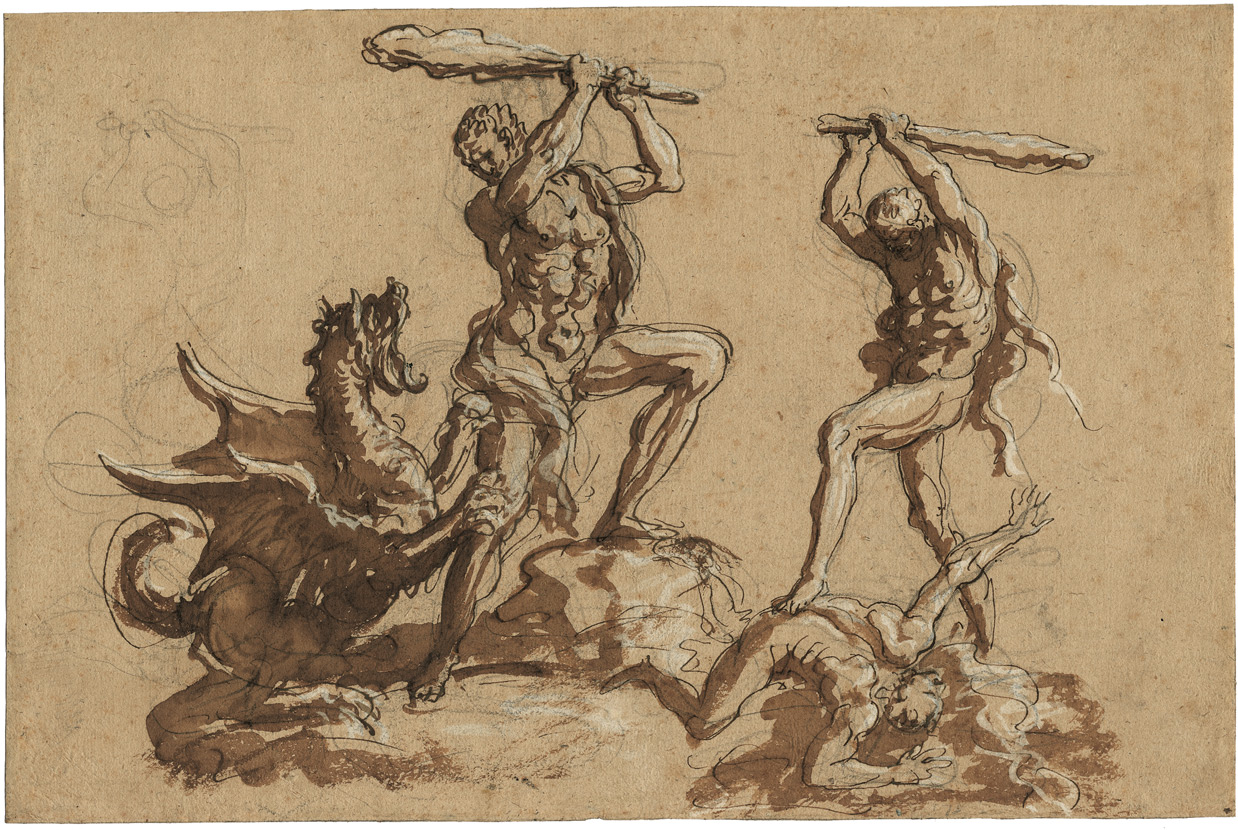Loading the page ...
Girolamo Troppa
(1630 Rocchette, Sabina – after 1710 Rome)
Hercules and the Lernean Hydra; Hercules Killing Cacus. Pen and brown ink over a light preliminary drawing in black chalk, brown wash, heightened with white. 26.7 x 40 cm.
In 1656 Cavaliere Girolamo Troppa began his career as a painter in Rome, where his work was influenced by such masters as Giacinto Brandi and Pier Francesco Mola. He moved in the artistic ambience of Roman High Baroque and in 1672 assisted none other than Giovanni Battista Gaulli. In the subsequent period he also collaborated with such artistic personalities as Giovanni Battista Beinaschi, Daniel Seiter and Giuseppe Ghezzi. Troppa’s artistic activity led him over the borders of Latium to Umbria and the Marches. In view of the multiple sources of inspiration that he drew on for his art, Troppa is an elusive personality as a painter. His paintings are rare, and in the past many of his works have been listed in museum collections under a different name.
The same observation applies to his drawn oeuvre, which was long overlooked by scholars. Erich Schleier deserves the credit for two ground-breaking essays which substantially add to our knowledge of this aspect of Troppa’s artistic activity and expand the small oeuvre through a series of new attributions (see E. Schleier, “Disegni di Girolamo Troppa nelle collezioni tedesche e altrove”, Antichità viva, XXIX, No. 6, 1990, pp. 23–34, and “Aggiunte a Girolamo Troppa pittore e disegnatore”, Antichità viva, XXXII, No. 5, 1993, pp. 16–23). In these two articles Schleier published a body of drawings, mainly composition sketches, which until then had often been kept, with the most divergent attributions, in German and foreign museum collections or in private hands. What is characteristic of this group of autograph drawings is their close similarity in the choice of technique. Most of them are pen drawings in brown ink with brown wash. Many of the drawings bear an inscription with the name of the artist, which is probably a signature in the artist’s own hand. Quite a few of them show a certain stylistic affinity with Gaulli, but on the whole Troppa’s linework is more energetic, forceful and filled with a feverish inner momentum that anticipates Venetian art of the 18th century, which is why some of his drawings used to be attributed to Gaspare Diziani or Girolamo Brusaferro.
The present, masterly and unusually suggestive study sheet, whose format is larger than most of the drawings that have been identified so far, cannot be linked to any painting by Troppa. It could be a composition sketch for a major decorative cycle de-voted to the labours of Hercules. The stylistic analogies to the artist’s confirmed works are self-evident. Two drawings in particular, at present in the Graphic Collection in Düsseldorf and containing scenes of the Passion, show a very similar treatment and use of light (see E. Schleier, op. cit., 1993, p. 21, figs.
17–18).
Over a light, spirited preliminary drawing Troppa has sketched the protagonists of the two scenes vigorously and with astounding virtuosity. The hasty, agitated penwork lends the portrayal a maximum of dynamism and sense of combat. The fluid, expertly done washes give the wildly flailing figures and the rearing mythological creatures a remarkable vividness and physical presence, creating an unsettling, flickering chiaroscuro appropriate to the drama of the scene. The rocky terrain has been rendered sketchily but effectively with only a few broad strokes of the brush. Great graphic skill is shown in the delicate, sparing use of white heightening, which creates delightful light effects and lends the portrayal flair and panache. Everything
radiates stylistic élan and an effortless mastery of the medium, making this drawing an important enrichment of Troppa’s graphic oeuvre.
